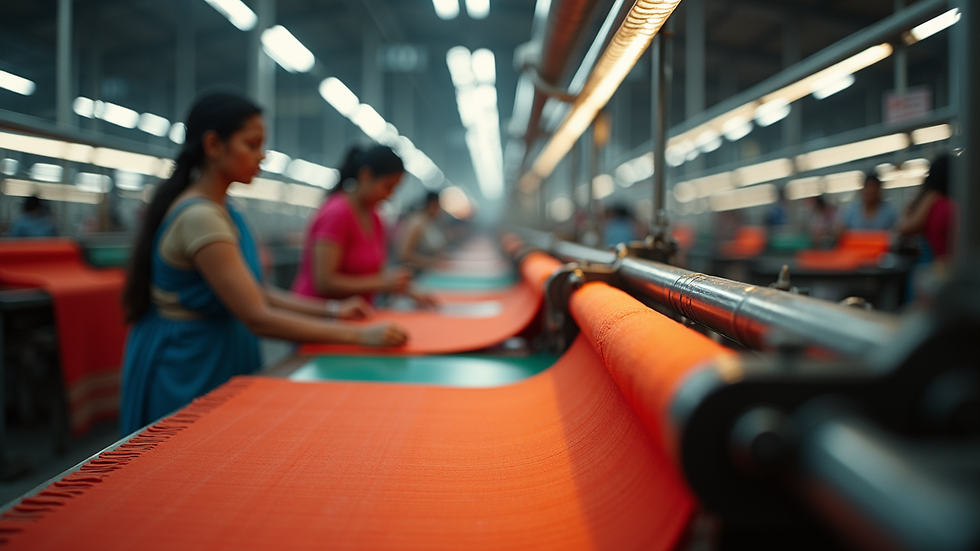Exploring the Journey of Supima Farming and Its Transformation in India's Manufacturing Sector
- Libin Lazar
- May 14
- 4 min read
The journey of Supima cotton from fields to fabric is not just a tale of agriculture; it’s a transformation that has significant implications for the textile industry. As global demand increases, particularly for high-quality products, India's manufacturing sector is stepping into the spotlight. This post takes a closer look at the Supima farming process, the rich textile traditions of India, and the skilled artisans behind the creation of luxurious cotton garments.
Understanding Supima Cotton
Supima cotton, celebrated for its softness and durability, originates exclusively from the United States. This extra-long staple cotton represents only 1% of global cotton production yet commands a premium price due to its superior strength and color retention. Farmers devote considerable time and resources to cultivate Supima, often employing practices that take into account soil quality and climate conditions. These farmers must follow stringent guidelines to ensure their cotton meets the high standards expected from Supima products.
For instance, understanding the right pest control strategies can lead to better crop yields. Statistics show that farms that implement integrated pest management can reduce losses by up to 30%, which is crucial for a premium crop like Supima.
The Journey of Supima from Farm to Fabric
After harvest, Supima cotton undergoes several stages: ginning, spinning, and weaving. Each step in this process is essential in creating the final fabric.
Ginning: This is where the cotton fibers are separated from the seeds.
Spinning: Here, the fibers are twisted into threads ready for weaving.
For instance, in a typical spinning facility, the transition from fiber to thread may result in a production rate of around 300 pounds of cotton per hour. Following spinning, the threads can be woven or knitted into fabrics using both advanced machinery and traditional techniques.
Many factories in India enhance these processes using modern technology. For example, some facilities have recorded a 20% reduction in production time while maintaining fabric quality due to the integration of automated weaving technologies.
Traveling to India for Manufacturing
Exploring India's manufacturing scene provides a unique perspective on the intricacies of Supima cotton production. Regions such as Gujarat, Maharashtra, and Tamil Nadu are well-known for their textile expertise.
Visiting these hubs, one can witness first-hand the combination of advanced technology and artisanal skill. For instance, a factory in Gujarat is capable of producing 100,000 meters of fabric each month, showcasing the craftsmanship and dedication of its workers. Each tour reveals the vibrant colors and textures of dyed fabrics, offering insights into the time and passion artisans invest in their work.

The Role of Professionals in Supima Manufacturing
The journey from cotton to garment is heavily reliant on the skills of a variety of textile professionals. Designers, engineers, quality inspectors, and production managers all play vital roles.
Their expertise encompasses understanding material properties, innovative dyeing techniques, and garment construction. For example, a quality inspector may evaluate several hundred garments daily, ensuring that each meets rigorous standards for durability and aesthetic appeal.
Moreover, many manufacturers in India are committed to ethical practices, which is reflected in their sourcing strategies. With continuous training programs, they equip the workforce with the latest technologies; this investment in people helps raise the overall quality of Supima cotton products.
The Economic Impact of Supima Cotton in India
The rising interest in manufacturing Supima cotton in India is pressing economic benefits. Establishment of production facilities has proven advantageous, creating thousands of jobs and fostering skill development.
According to industry estimates, the export value of Supima-based textiles from India has risen by over 15% annually. As international demand increases, Indian manufacturers are well-positioned to cater to consumers looking for ethically sourced, high-quality fabrics.
This booming market not only benefits economic growth but supports sustainable farming practices. By providing stable incomes for farmers, the industry helps build resilient communities.

The Future of Supima Cotton in Global Markets
The outlook for Supima cotton in India is bright as manufacturers increasingly grasp its potential. With a consumer shift toward sustainability, the demand for ethically sourced and high-quality materials is on the rise.
Technological advancements and changing consumer preferences are reshaping the textile landscape. Manufacturers who embrace these shifts and focus on both quality and sustainability will find success in a competitive market.
Further collaboration between U.S. cotton farmers and Indian manufacturers could enhance best practices, reinforcing the consistency and quality of Supima cotton. Such partnerships present significant opportunities for innovation in textile production.
Final Thoughts
The journey of Supima cotton, from the fields of the U.S. to the skilled hands of artisans in India, highlights the importance of quality and sustainability in textiles. As consumer interest in ethical and high-quality products grows, India is emerging as a leader in the global Supima market.
The dedication of professionals, along with innovative practices, creates a promising future for Supima cotton in India. This enduring journey shows how traditional techniques and modern technology can work hand in hand, shaping an industry rich in cultural heritage and poised for growth. The artistry involved in transforming a simple plant into luxurious fabrics deserves appreciation and recognition worldwide.

Comments